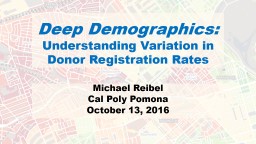

Michael Reibel Cal Poly Pomona October 13 2016 My Background in Donor Research United Network for Organ Sharing CoInvestigator for Geography and Demographics Deceased Donor Potential Study 20112013 ID: 1001176
Download Presentation The PPT/PDF document "Deep Demographics: Understanding Variati..." is the property of its rightful owner. Permission is granted to download and print the materials on this web site for personal, non-commercial use only, and to display it on your personal computer provided you do not modify the materials and that you retain all copyright notices contained in the materials. By downloading content from our website, you accept the terms of this agreement.
1. Deep Demographics:Understanding Variation in Donor Registration RatesMichael ReibelCal Poly PomonaOctober 13, 2016
2. My Background in Donor ResearchUnited Network for Organ Sharing. Co-Investigator for Geography and Demographics, Deceased Donor Potential Study. 2011-2013. California Transplant Donor Network (Now Donor Network West - Northern California regional organ bank). 2014. PI. Market research study on donor population patterns. OneLegacy (Southern California regional organ bank). 2012-2013. PI. Market research study on donor population patterns. Reibel, M., Olmo, C. Andrada, S. and Koertzen, J. 2016. Deep Demographics: Understanding Local Variation in Donor Registration Rates. Progress in Transplantation Vol. 26(2) 191-198.
3. The ProblemNot enough donor organs – especially kidneys – to go aroundAlternatives to transplantation include either death (very frequently), or terrible quality of life (e.g. dialysis)
4. The SolutionsLong term: Artificial organsShorter term: Live donation (kidneys, partial liver)Maximize deceased donors
5. Pathways of Deceased DonationDonor Registries (Donate Life California)Legally bindingCan be done onlineNext of Kin consent
6. Obstacles to Deceased DonationCultural (especially religious) beliefs about the integrity of the corpse – often involve resurrection, the afterlifeFear and concern regarding withholding of medical care at end of life (notably among African Americans)Failure to understand the value of donation (notably among immigrants and the less educated)Children of elderly parents skeeved out by the notion of dissection for organ recovery
7. InterventionMicro targeting of individuals and communities based on multiple demographic indicators associated with depressed donation ratesSupported by research on these complex associations of factors with the willingness to donate
8. DataData for registrants on the organ donor registry were provided by Donor Network West. There were 3,650,028 registrants reported in the California. These were aggregated to the zip code level as local counts. The census data used to model social environments for the DNW service area were 2012 five-year sample American Community Survey data at the zip code level of aggregation.The local counts of registered donors were divided by their respective zip code populations to yield local registration rates (the dependent variable).
9. MethodsOLS models regressing local registration rates on a set of social environment factors Specified social environment factors in models two ways:As separate variables selected based on local population patterns As complex social ecosystems identified through a data-driven classification (k-means cluster analysis)
10. Why Cluster Analysis?Immigrants have lower donor registration ratesThe less educated have lower donor registration ratesBUT which have lower rates: well educated immigrants or the less educated native born?These sorts of non-linear and asymmetrical interactions are the reason neighborhood sociodemographic profiling techniques of the sort used here are the industry standard in market research.
11. Model 1: Separate Variables(Constant)-869.847**Total Population0.271**Median Household Income0.008*>= Bachelor’s Degree42.216**%Non-Hispanic Black-3.461 %Born in China (incl. HK & Taiwan)-12.907 %Born in Vietnam-189.174**%Born in Mexico-30.211**%Born in Central America-69.63 %Born in Philipines-123.669**%Born in SW Asia-40.172Adjusted R2, (F test of model significance) .846
12. Discussion, Model 1Income and education effects are powerful and significantAfrican American effect is not significant when income and education are controlled forAll foreign born nationalities associated with lower registration but only Mexico and SE Asia significant
13. Cluster Zip Code Area Variable1234567Land Area-0.470.09-0.19-0.105.00-0.36-0.45Dependency Ratio (Old)-0.23-0.016.85-0.380.18-0.05-0.39Dependency Ratio (Child)-0.270.04-1.120.63-0.31-0.230.24Non-Hispanic Black %0.69-0.32-0.391.47-0.33-0.050.26Non-Hispanic Asian %3.89-0.40-0.420.41-0.440.033.32Hispanic %0.39-0.35-0.582.07-0.40-0.262.03Median Household Income0.79-0.55-0.38-0.18-0.200.930.43Some High School %-0.320.29-0.650.44-0.03-0.620.40Bachelors or Higher %0.91-0.58-0.20-0.49-0.181.11-0.10Came to U.S. 2000 or later %2.82-0.47-0.581.36-0.52-0.072.66Foreign Born %2.89-0.48-0.581.37-0.53-0.073.13Born in China %4.22-0.31-0.280.05-0.310.050.90Born in Vietnam %1.36-0.23-0.250.16-0.24-0.097.75Central America %0.35-0.32-0.512.04-0.37-0.291.93Born in Mexico %0.08-0.29-0.502.02-0.35-0.301.97 Born in Philippines %2.59-0.30-0.340.60-0.33-0.062.61The Social Environment ClustersVariable Cluster Centers Expressed as Z scores (standard deviations)
14. Social Environment Clusters: Summary & DescriptionCluster# of zips in Cluster DescriptionLocation Pattern 127Urban, diverse, moderate to high socio-economic status, high concentration of Asian immigrantsSan Francisco City (less affluent) and some inner suburbs2430Native white, lower socioeconomic statusOuter non-Bay Area suburbs, small town, rural39Elderly, native white, moderate socioeconomic statusRural494Diverse (Black and Hispanic), many families with children, moderate concentration of immigrants, lower socioeconomic statusAgricultural areas (San Joaquin and Salinas Valleys), African American concentrations in the Bay Area 515Rural, native white, low to moderate socioeconomic statusRural (remote, low density)6250Moderately diverse, high socioeconomic statusWealthy San Francisco neighborhoods and outer Bay Area suburbs 710Urban, younger, diverse (Asian and Hispanic), moderate socioeconomic status, very high foreign bornMilpitas and East San Jose (border of East Bay/South Bay)
15. 1San Francisco City (less affluent) and some inner suburbs2Outer non-Bay Area suburbs, small town, rural3Rural4Agricultural areas (San Joaquin and Salinas Valleys), African American concentrations in the Bay Area 5Rural (remote, low density)6Wealthy San Francisco neighborhoods and outer Bay Area suburbs 7Milpitas and East San Jose (border of East Bay/South Bay)
16. Effects of Cluster Membership on Predicted Registration Count Relative to Omitted Cluster 2(Constant)-204.945&Total Population.302**Cluster1-1786.476**Cluster3417.236 Cluster4-3123.535 **Cluster5 -119.357Cluster6 1327.898**Cluster7-5597.660 **Adj. R2, (F test of model significance) .844(**)
17. Discussion, Neighborhood Profile ModelExcept at the highest levels of SES, race, ethnicity and immigration drive variation in registration. With the same exception, the interactions between these factors appear mostly linearThe outlier is Cluster 6: The wealthiest cluster of zip code areas, but one that is relatively diverse in terms of ethnicity and immigration. Cluster 6 has by far the largest positive effect on registration of any of the clusters. We can conclude that beyond some unidentified threshold of SES, identity apparently no longer matters and registration is uniformly high. This finding shows the power of the cluster analysis approach for discovering joint effects that differ from straight linear interactions.